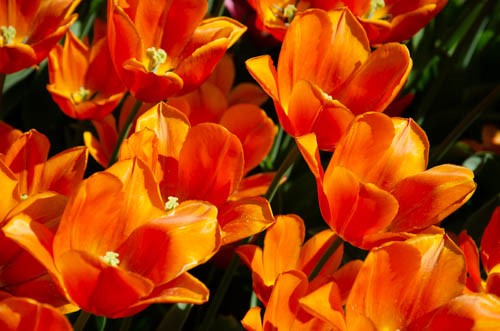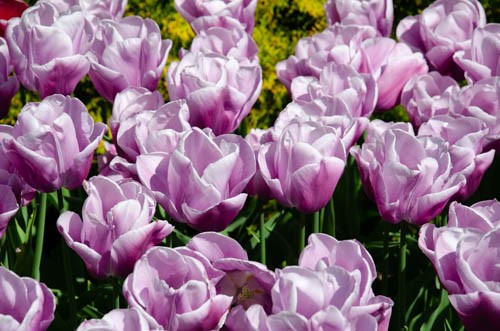Tulips – April 2019

Anonymous 17th-century watercolor of the Semper Augustus, famous for being the most expensive tulip sold during the tulip mania.
April is tulip month in Holland. There are tulip festivals and tulip tours. The best place to see every variety of tulip is the Keukenhof Gardens, near Amsterdam.
We associate tulips with Holland however tulips did not originate in the Netherlands. The history of the tulip begins in a desolate area in central Asia.
“Taxonomists believe that the first tulip sprang from the scrubby slopes of the Pamirs and flourished among the foothills and valleys of the Tien Shan Mountains, where China and Tibet meet Russia and Afghanistan in one of the least hospitable environments on earth” [1]
From central Asia to the Ottoman Empire, the tulip did not arrive in the Netherlands until the mid-16th century.
The first tulip seeds were sent to Vienna in 1554. From Vienna tulip bulbs traveled to Amsterdam, Antwerp and Ausberg.
It can take up to 12 years for a tulip bulb to flower from a seed.
Tulips were, for a while, a rare commodity. During the Golden Age of the Netherlands, only the wealthy could afford tulip bulbs.
“Some tulips were so scarce and so greatly coveted that they were worth more than a hundred times their weight in gold, and successful bulb dealers could make huge profits” [2]
In the 1600’s the price of tulip bulbs skyrocketed creating what is called Tulip Mania.
Tulip Mania is the story of people going crazy speculating in tulip bulbs. It became a “get rich quick” frenzy.
When economists talk about speculative bubbles in asset prices, the tulip is often used as an example of the first asset price bubble to burst.
“Many individuals grew suddenly rich. A golden bait hung temptingly out before the people, and, one after the other, they rushed to the tulip marts, like flies around a honey-pot. Everyone imagined that the passion for tulips would last forever, and that the wealthy from every part of the world would send to Holland, and pay whatever prices were asked for them. The riches of Europe would be concentrated on the shores of the Zuyder Zee, and poverty banished from the favoured clime of Holland. Nobles, citizens, farmers, mechanics, seamen, footmen, maidservants, even chimney sweeps and old clotheswomen, dabbled in tulips.” [3]
Tulip Mania has a specific financial context. The bubble bursting is one we recognize from the dot com era and the real estate crash. The financial context for the tulip may surprise you.
The Dutch were financial innovators.
In 1602 the first stock exchange was established in Amsterdam. The Dutch East India Company (VOC) was the first company to issue publicly traded shares on the Amsterdam Stock Exchange.
Later renamed the Amsterdam Beurs, trading on the Beurs was strictly regulated.
Options (puts and calls), futures contracts, margin buying, and stock index trading were quite common in the Netherlands in the 1600’s.
By 1636 over 360 different commodities were traded on the Amsterdam Beurs.
Tulips, however, were not traded on the exchange and this is one reason speculation in tulips persisted.
Bulbs were traded via futures contracts, today known as forward contracts.
Trading tulip bulb futures contracts was done through auctions.
Auctions took place anywhere at anytime and typically in a pub. Over a pint or many pints.
“The price of tulips skyrocketed because of speculation in tulip futures among people who never saw the bulbs. Many men made and lost fortunes overnight. “[4]
Trading in futures contracts today, is the same as it was in the Netherlands over 400 years ago.
Commodities are bought and sold at on an agreed upon price for delivery at a future date. Without the actual commodity ever changing hands.
A basic commodity futures contract works like this: tulip bulbs blossom in April and May.
If a florist wanted to make sure they had a supply of tulips in the future, the florist would agree to pay the tulip grower a price today for delivery of the tulips in April and May.
In today’s markets we use futures contracts to trade in currencies, agriculture (wheat, corn, soybean), metals (gold and silver), energy (oil and gas) orange juice and livestock.
We use futures contracts to trade in equities and interest rates.
Fortunately for the Dutch, the strength of their economy did not rely on the tulip bulb. Tulip prices crashed but their economy did not.
If you look at the individual holdings in a mutual fund it is likely you will see futures contracts.
But not for tulip bulbs.


Photos by Michael A. Sallette. Keukenhof Gardens, Amsterdam, The Netherlands
[1] Tulipomania. The story of the world’s most coveted flower and the extraordinary passions it aroused. Copyright © 1999 by Mike Dash
[2] Tulipomania. The story of the world’s most coveted flower and the extraordinary passions it aroused. Copyright © 1999 by Mike Dash. Page 2.
[3] https://en.wikipedia.org/wiki/Tulip_mania
Mackay, Charles (1841), Memoirs of Extraordinary Popular Delusions and the Madness of Crowds, London: Richard Bentley
“The Tulipomania”, Chapter 3
[4] https://en.wikipedia.org/wiki/Tulip_mania
Additional Resources:
https://en.wikipedia.org/wiki/Euronext_Amsterdam
https://tulipfestivalamsterdam.com/amsterdam-tulip-season-2019/
This website is for informational purposes only and does not constitute an offer to sell, a solicitation to buy, or a recommendation for any security, nor does it constitute an offer to provide investment advisory or other services by The Modest Economist LLC.
